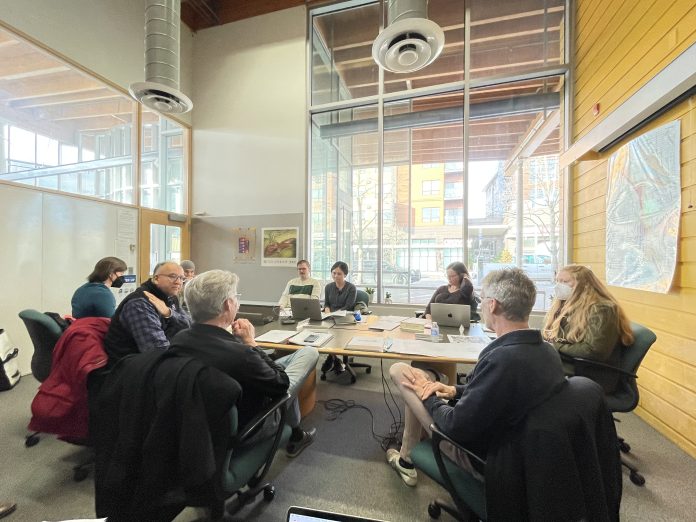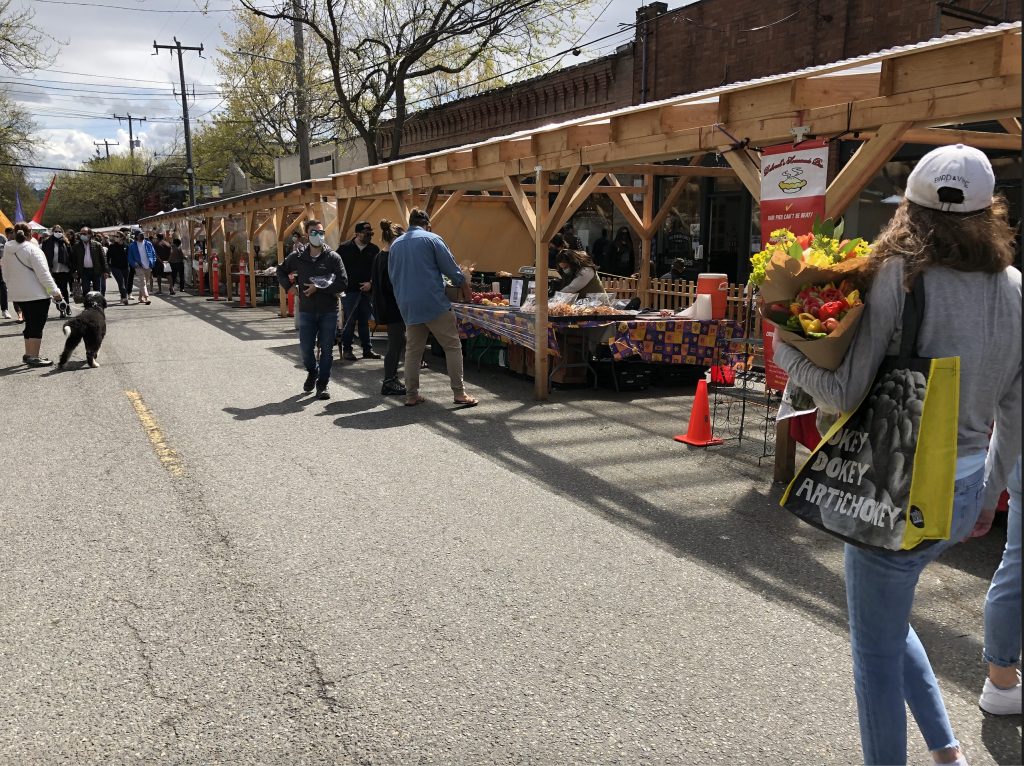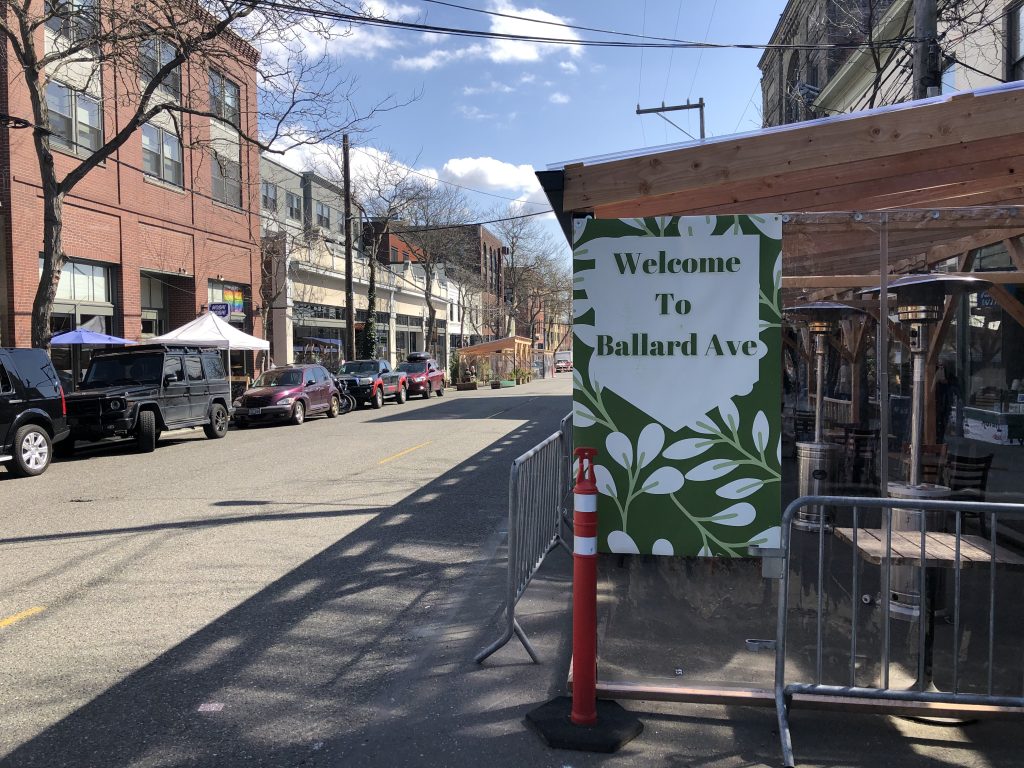
The future of wildly popular streateries now rests in a narrow view of the street’s past.
It’s 9am on a Thursday morning in the multipurpose room of the Ballard Service Center. Six of the seven members of the Ballard Avenue Landmark District Board sit around a conference table with a Seattle Department of Neighborhoods staff member. At the request of Councilmember Dan Strauss, the board is trying to develop a one-page summary of guidelines for what an acceptable outdoor eating area would look like. It’s not going well.
Board member Richard Hiner of Richard Hiner Architects is absolute about the concept of an acceptable covered outdoor eating area. To him, the one-pager “feels like this to me is the same thing that’s there now and they don’t comply and they’ll never be appropriate.” Anthony Salazar, the board’s community historian, posits “The moment a two-by-four went down, there it goes. I don’t want to say they defile the historic district, but it did.”
It’s not all bad. Board member Miriam Hinden, an architect with Atelier Drome, does get in the line, “if the streateries are not there, then what do we have? Cars. Why are we supporting cars instead of economic vitality.” And board member Tommy Patrick of The Ballard Cut restaurant (and original pergola constructor) spoke to the benefit of bollards.
Through city law and political deference, this board holds outsize sway in deciding whether or not the wildly popular pergolas will get to continue in their present form on Ballard Avenue. Even with the voices of support, it’s not looking good.

In December, Councilmember Strauss ushered through legislation that made cafe streets a permanent addition to the city. Except there was an amendment added that gave cafe streets an extra six months to get their stuff together in historic districts. The intransigence in this room shows why.
Ballard’s unique pergolas arose during the pandemic through cooperation between the Farmer’s Market, local businesses, and City Hall. City-wide, pergolas and street cafes exist in a difficult quasi-public pressure point. As they are constructed on city-owned land, namely the street, the cafe structures will always be temporary. If Seattle Department of Transportation (SDOT) needs to do utility work on the street, the pergola has to go. However, the temporary-ness also dictates how much money the business owners are willing to spend on the spaces. They have to make their money back on the investment and prefer predictability in pricing.
The success of the outdoor spaces during the pandemic has led to a complete reconsideration of the permitting process. Now, instead of charging for the “lost” revenue of a parking space, SDOT is charging applicants the cost to review the application. That’s just over $1,000 for a new application, and $580 for a renewal.
Enter the historic district. The one-pager requested by Strauss is part of this predictability concept. Businesses will be more likely to invest if they know what has a preliminary okay. But the longer duration the pergolas will have, the more the historic district board wants the structures to fit into the permanent requirements of materials being compatible with the brick and cast iron that’s typical on the street. The cost of such construction is, predictably, far too high for a temporary structure.
Thus the impasse as new concepts don’t get listed in historic district design rules. Indeed, the historic district guidelines have zero mention of street cafes. The closest things mentioned are street furniture, which include “bollards, signal boxes, mail boxes, pay phones, trash receptacles, newspaper stands, benches, planters and vending carts that are permanent or mobile.” Google suggests that the nearest pay phone is at an Arco in Sacramento.
And that’s the thing. The Ballard Historic District was designated in 1976. It is now as old as some of the contributing buildings were when the area was designated, and 10 years older than the average Seattle resident. Moreover, the Ballard district was established only a decade after the nation’s historic preservation laws were established — geared towards saving old East Coast mills and train stations. Seattle is not an old city, yet some parts have spent almost half their existence set aside as “historic.”
In the meeting, the conversation turns from the specific design of an allowable pergola to an overall discussion of the streetscape and whether pergolas fit in at all. There is no mention of the popularity of the street cafes or Ballard Farmer’s Market using the canopies on Sundays. It is all very focused on how much the roofs interfere with the panoramic view of the historic street.
With that, a discussion arises of proper roof pitch, and whether to allot a limited number of roofs to be allowed on the street. That gets a comment from city staff that lotteries and caps would need to be cleared with the city attorney’s office.
Board member Joe Herrin, an architect with Heliotrope Architects but on the board as owner of The Heritage Building, finds this to be a Catch-22. “If we put limits on who has roofs,” he says, “then there are equity concerns. And if there are not limits on the number of roofs then I’m never voting for it.”
If this absolutism about the covered cafes seems silly, that’s because it kind of is. The initial inventory completed for Ballard’s National Register designation (.pdf) notes “between Ballard’s incorporation in 1890 and the time of the community’s annexation to Seattle in 1907, a great many wood-frame structures were built, naturally. Some of the clapboard dwellings and shops with their false fronts and Italianate cornices stood for decades. Most, however, were soon torn down and replaced by more permanent construction.” Requiring pergolas to make an immediate leap to stone means that the same evolution that created Ballard’s unique look is no longer allowed.
The inventory also mentions that “there were no street plantings, nor were there any statuary or park parcels. The City Beautiful Movement by-passed Ballard’s Triangle.” However, trees are now a welcome addition to the streetscape, even if they were not original contributing parts of the historic district. The board complemented SDOT for filling the tree wells with rubberized permeable fill. Many of those trees block significant portions of the historic building frontages, just like some board members are complaining about the pergolas.
The current success of businesses in the neighborhood lets folks overlook why a bunch of old buildings were still around in the first place. The National Register inventory points out that Ballard’s lack of change “owes largely to the fact that the community’s Post War development was attracted elsewhere,” notably Market and 15th Streets. The application was created “as an outgrowth of a locally-inspired revitalization movement.” Not a preservation movement. A revitalization movement.
These pergolas and cafe eateries have done more than revitalize a stretch of shops and restaurants that were hard hit by pandemic shutdowns. They’ve become iconic in their own right. Ballard’s streateries have become a blueprint for neighborhoods across the state who want to keep their restaurants and diners healthy, and make their street spaces productive for people rather than parking. Might not be the most historic looking things in the world, but totally within the original intent of the district.
Unfortunately, even supporters make an underlying concession that street cafe pergolas are eyesores. It’s a quiet stipulation that, just because they get this temporary label, the structures don’t have the exquisite gravitas of a brick facade. It’s such nonsense. The well-made pergolas have the look of a PNW lodge and a personality flexible enough to reflect the business. They look better than any parked car. But the thing that makes them most exquisite is that they’re filled with people, year round.
More importantly, they’re totally within the board’s ability to approve. Here’s the interesting thing about historic districts: they operate off architectural guidelines. At their core, the list of qualities that contribute to the look and feel of the historic street are subjectively applied to new structures. The district’s rules use words like “encourage” and “consistent.” Where the term “shall” picks up, it’s phrases like “shall be respected” and “shall be in keeping with the historic character.” A lively Ballard Avenue is completely within the historic character of the district.
Unfortunately, all that subjectivity is in the hands of eight people, some of whom are absolute in their interpretation that covered outdoor streateries do not fit in their neighborhood. The meeting begins to break up after Tommy Patrick and Joe Herrin agree to develop a proposed pergola design that will be the point of discussion in the future. The question of where and how many roofs will be allowed is passed to a future meeting. The Board will meet again at 9am on March 2nd in the Ballard Service Center. Public comment to the Board can be made through the Department of Neighborhoods website, or sent via email to the Board’s coordinator MinhChau.Le@seattle.gov and council@seattle.gov.
Ray Dubicki is a stay-at-home dad and parent-on-call for taking care of general school and neighborhood tasks around Ballard. This lets him see how urbanism works (or doesn’t) during the hours most people are locked in their office. He is an attorney and urbanist by training, with soup-to-nuts planning experience from code enforcement to university development to writing zoning ordinances. He enjoys using PowerPoint, but only because it’s no longer a weekly obligation.



